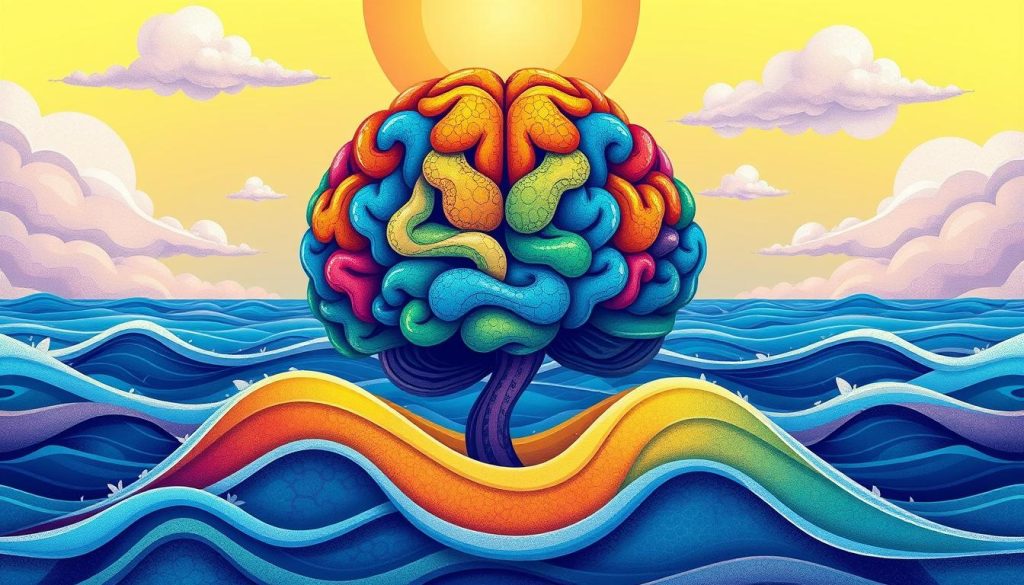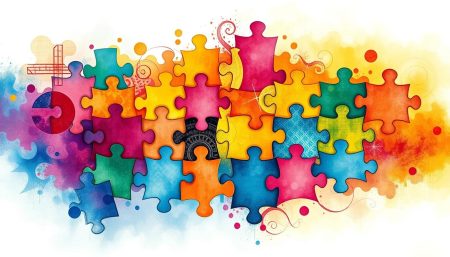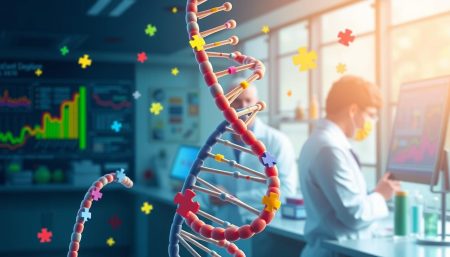Autism Spectrum Disorder (ASD) affects millions worldwide, changing communities and lives deeply. With autism awareness growing, it’s key to explore its many forms and its big impact. This piece aims to deepen our understanding of ASD, its effects, and the support available for those dealing with it.
Many trusted sources offer help and knowledge. The Centers for Disease Control and Prevention (CDC) share the latest on ASD’s impact. Groups like the Autism Society also play a big role in spreading awareness and understanding.
This conversation is vital. It helps break down stigmas and shares new research on ASD. This article is for both newbies and those looking to learn more. It covers the latest in support and research on ASD.
What Is Autism Spectrum Disorder?
Autism spectrum disorder (ASD) is a complex group of neurodevelopmental conditions. They vary greatly in how they affect people. This makes the ASD definition broad and inclusive, recognizing each person’s unique challenges and abilities.
Defining Autism Spectrum Disorder (ASD)
The American Psychiatric Association defines ASD as a condition with challenges in social interaction and communication. These challenges range from mild to severe and vary among individuals.
The Spectrum: Understanding the Range of ASD
The ASD range includes conditions like Asperger’s syndrome and autistic disorder. Each person on the spectrum has different symptoms, affecting daily life in unique ways.
Prevalence and Demographics of ASD
Autism prevalence has been rising. The Centers for Disease Control and Prevention (CDC) reports that about 1 in 54 children in the U.S. have ASD. This highlights the need for public health efforts to address ASD.
| Year | Prevalence of ASD | Population Studied |
|---|---|---|
| 2016 | 1 in 68 | 8-year-olds in U.S. |
| 2020 | 1 in 54 | 8-year-olds in U.S. |
| 2022 | 1 in 44 | 8-year-olds in U.S. |
Signs and Symptoms of Autism
Spotting autism signs early is key. It means looking for early clues that might mean a child needs a check-up. These autism symptoms can look different for everyone. They depend on the person’s age, how they develop, and how severe their symptoms are.
The American Academy of Pediatrics lists early signs of autism in kids. Autism Speaks also has a long list of symptoms that can show up at different times in a child’s life. Some common signs include:
- Lack of or delayed speech development
- Minimal eye contact or facial expression
- Consistent routine or repetitive behaviors (e.g., flapping, rocking, spinning)
- Unusual and intense reactions to sounds, smells, tastes, textures, and sights
- Poor social skills, including difficulty forming friendships and understanding social cues
Personal stories and case studies show how different autism symptoms can be. For example, some people might react strangely to touch or have a deep interest in certain topics. These signs vary a lot from person to person.
Recognizing autism signs early can really help a child. It leads to getting help and support sooner. It’s important to know that symptoms can look different every time and in different ways.
The Autism Diagnosis Process
Diagnosing autism is a key step that greatly affects how we support people with Autism Spectrum Disorder (ASD). Knowing how this process works helps us start early interventions. This is key to improving their lives and growth.
Initial Screening and Recognition of Symptoms
First, we use screenings to spot kids who might have autism. Doctors use special tools during check-ups at 18 and 24 months. Finding symptoms early is important for more detailed tests if needed.
Comprehensive Diagnostic Assessments
After screenings, experts like doctors and psychologists do deeper tests. They look at many parts of a child’s behavior and growth. Tools like the Autism Diagnostic Observation Schedule (ADOS) help make a solid diagnosis.
Importance of Early Diagnosis and Intervention
Getting a diagnosis early is very important for ASD management. It lets us start helping sooner, which can really change a child’s path. Programs that focus on talking, behavior, and social skills are key in helping with ASD challenges.
| Age | Screening Tool | Assessment Type |
|---|---|---|
| 18 months | Modified Checklist for Autism in Toddlers (M-CHAT) | Initial Screening |
| 24 months | Ages and Stages Questionnaire | Initial Screening |
| Post-screening | Autism Diagnostic Observation Schedule (ADOS) | Comprehensive Assessment |
Types of Autism Interventions
Looking into autism interventions shows a wide range of therapies and strategies. These are made to fit the unique needs of people with ASD. From proven methods to new ideas, the world of autism treatment is full and varied. Each one aims to tackle specific challenges, helping people with autism live more independently and happily.
- Behavioral Therapies: These are key treatments, like Applied Behavior Analysis (ABA). They work by encouraging good behaviors and reducing bad ones.
- Educational Interventions: Special education and individual plans help with learning. They make sure education is both accessible and effective.
- Speech and Occupational Therapy: These therapies improve how people communicate and deal with sensory issues.
- Emerging Technologies: New tech like virtual reality and AI programs are opening up new ways to learn and engage.
| Intervention Type | Primary Focus | Age Group |
|---|---|---|
| Behavioral Therapies | Behavior Modification | All Ages |
| Educational Strategies | Learning and Adaptation | Pre-school to College |
| Speech Therapy | Communication Skills | Early Childhood Onward |
| Occupational Therapy | Sensory Integration | Toddler to Adult |
Healthcare experts in autism treatment keep updating these interventions. They make sure they match the latest research and the person’s progress. They focus on care that’s just right for each person, changing things as needed.
The success of these treatments often depends on early diagnosis and the right therapy. Thanks to clinical trials and the National Institute of Mental Health, autism treatment and interventions are getting better. There’s a push to make these services more available to help more people and families with ASD.
Coping Strategies for Individuals with ASD
It’s key to find good ways for people with Autism Spectrum Disorder (ASD) to cope. This helps them live better lives and deal with social, school, and sensory issues. Let’s look at some top strategies.
Communication and Social Interaction Strategies
Learning social skills is a big deal for those with ASD. Speech-language pathologists teach them through role-playing and social stories. These methods improve talking and understanding body language and facial expressions.
Behavioral and Educational Interventions
Behavioral interventions are very helpful for ASD. Applied Behavior Analysis (ABA) is used to promote good behaviors and reduce harmful ones. Schools and therapists create plans that fit each person’s needs, making learning places where ASD kids can do well.
Sensory Integration Techniques
Sensory integration helps with the sensitivities many with ASD face. Occupational therapists use therapy and tools like weighted vests to help. Adding calming activities to daily life can lessen sensory overload and improve coping.
Understanding Autism Spectrum Disorder in Everyday Life
Living with ASD every day comes with its own set of challenges and chances to grow. It affects both those with autism and those around them. Knowing about autism daily challenges helps us understand and support better.
For those with ASD, simple tasks can be big hurdles. These tasks show how autism affects us in our daily lives. Things like talking, socializing, and handling different sounds and sights make everyday routines more complicated.
- Autistic people share how important routine is to reduce stress.
- Family blogs talk about how small changes can upset an autistic person’s routine.
- Research shows the big challenges and barriers people with ASD face every day.
These stories and studies paint a detailed picture of how ASD changes daily life. They show that understanding and support that fit each person’s needs are key to a supportive environment.
To support those with autism and their families, we need to spread awareness and promote inclusion. This helps them fit in better and celebrate their special qualities in our communities.
Autism Spectrum Disorder’s Impact on Families
Autism spectrum disorder (ASD) brings many challenges to families. It affects emotions, finances, and education. Each family member is touched differently, needing a wide range of support to cope.
Emotional and Financial Considerations
Getting an ASD diagnosis can be very hard on families. They worry about the child’s future and managing their needs. This can put a lot of stress on family relationships and personal health.
The cost of therapies and care can be very high. Many families struggle to find enough money for these needs.
Family Dynamics and Support Networks
Having a family member with ASD changes family life a lot. Parents and siblings may take on new roles like caregivers and advocates. They might need to adjust their personal and work lives.
Strong ASD support networks are key. They offer help, advice, and emotional support to those caring for a family member with ASD.
Navigating School and Social Settings
Getting a child with ASD into school is another big challenge. Autism in schools requires teamwork between families and schools. They need to work together to make sure the child gets the right support and education.
Helping a child with ASD succeed in school is important for their growth and happiness.
- Emotional support sessions for family members
- Financial planning and assistance programs
- Workshops on engaging with schools and community resources
It’s vital to understand and help families deal with autism’s effects. This helps families stay strong and find support from their community.
Pathways to Autism Treatment
Finding the right autism treatment can be tough. But knowing the different ASD therapy paths can help families make good choices. Every person is different, so it’s key to try various therapies like behavioral interventions, speech therapy, and special education plans.
To pick the best treatment options, talking to many specialists is a good start. Looking at clinical guidelines from trusted neurology groups is also important. These resources help understand which therapies work best, helping create a treatment plan that fits.
| Treatment Type | Description | Effectiveness Rating |
|---|---|---|
| Behavioral Therapy | Improves specific behaviors, like social skills or communication challenges. | High |
| Speech Therapy | Boosts communication skills, helping with both talking and non-verbal abilities. | Medium to High |
| Occupational Therapy | Helps with daily tasks, improving thinking, physical, and motor skills. | Medium |
| Pharmacological Interventions | Uses medicines to manage symptoms like irritability and aggression, often with other therapies. | Varies |
Studies show that mixing different ASD therapy pathways in a treatment plan works well. This mix of therapies helps people with ASD live better lives, improving their independence and happiness.
Looking at treatment journeys through case studies and medical journal analyses gives real insights. It shows how to manage ASD symptoms effectively.
Managing autism often means making changes and learning new things. Joining communities and support groups offers emotional support and shared experiences. These can help guide others through similar challenges.
Choosing the right autism treatment options means always learning and adapting. As people grow, their treatment plans need to change too. This ensures the strategies keep helping them develop and stay well.
Misconceptions and Myths About ASD
In our journey to understand Autism Spectrum Disorder (ASD), we must tackle common myths and stereotypes. These beliefs shape how society views and treats people with autism.
Dispelling Common Autism Myths
One harmful myth is that vaccines cause autism. Research has shown this is not true. Another myth is that all people with autism have special talents, like being super smart in math or art. But, most do not have these abilities.
How Stereotypes Affect Individuals with Autism
Autism stereotypes can lead to wrong beliefs. People think those with autism don’t feel emotions or want friends. These stereotypes hurt their chances in school and work.
Separating Fact from Fiction
We need to rely on facts to fight misinformation. Knowing the truth about ASD helps create a better world for those affected by it.
| Myth | Fact |
|---|---|
| Vaccines cause autism | No scientific evidence supports this claim |
| All individuals with autism have savant abilities | Only a small percentage exhibit such skills |
| Autistic individuals prefer to be alone | Many seek social interactions but may find them challenging |
By debunking myths and stereotypes, we open doors to a more understanding society. This helps individuals with autism live better lives.
Building an Inclusive Society for Autism Spectrum Disorder
An inclusive society helps everyone grow, including those with Autism Spectrum Disorder (ASD). It’s key to promote autism inclusivity and autism acceptance everywhere. This way, everyone can do well in their community.
Schools and workplaces are key to this. Schools should teach in ways that work for all students. Workplaces should be welcoming, letting people with ASD contribute and feel important.

Studies show that removing barriers helps people with ASD do well. Success stories from different areas show better wellbeing and work when places are inclusive. Groups and global efforts help by raising awareness and making policies.
The United Nations also supports these efforts. They work to ensure everyone’s rights are respected, including those with ASD. Their work shows how important it is to treat everyone with dignity.
| Sector | Initiatives for Autism Inclusivity |
|---|---|
| Education | Implementation of specialized training for teachers, development of an inclusive curriculum. |
| Workplace | Creation of ASD-friendly work environments, supportive employment practices. |
| Community | Awareness programs, support groups, accessible community facilities. |
Working together, we can make a society that accepts autism fully. It takes effort from all areas, support from groups, and a strong belief in equality and inclusivity.
Autism Spectrum Disorder in the Classroom
Creating a supportive classroom for students with Autism Spectrum Disorder (ASD) requires special strategies and teacher training. This helps students feel included and meet their unique educational needs. It’s all about making the classroom a place where everyone can thrive.
Educational Adjustments for Student Success
For students with ASD to succeed, classrooms need to be specially adjusted. This includes making the space more sensory-friendly and setting up routines that students can follow. Visual aids and technology also help students understand and participate in class better.
Teacher Training and Awareness
Teachers need special training to work well with students who have ASD. This training helps them understand and manage the challenges these students face. It covers how to handle behavior, communicate effectively, and use technology to help students learn.
The Role of Individualized Education Programs (IEPs)
Individualized Education Programs (IEPs) are key for students with ASD. They set goals that match each student’s strengths and challenges. Teachers, parents, and specialists work together to create a plan that helps students learn and grow.
Autism Spectrum Disorder in the Workplace
Understanding autism employment and workplace inclusion for ASD is key for a supportive work place. Companies now see the value of hiring people with ASD. They bring unique skills and views to the job.
People with ASD face challenges like sensory issues and needing clear job expectations. By tackling these, we make the workplace better for everyone. It becomes more welcoming and flexible.
Top companies lead the way in autism employment. They use special recruitment, onboarding, and support systems. These efforts help ASD individuals fit in and stay longer, improving team and diversity.
Stories of success show how workplace inclusion for ASD benefits everyone. Employee groups and mentorship help meet different learning and communication needs.
- Structured work environments help individuals with ASD to thrive
- Customized job responsibilities to align with individual strengths
Vocational support programs are vital for job seekers with ASD. They offer training and internships tailored to autism needs. This prepares them for various jobs.
There’s a rise in hiring people with ASD, thanks to better awareness and programs. This growth boosts workplace inclusion for ASD and makes the economy more diverse and vibrant.
Legal Rights and Advocacy for Autism Spectrum Disorder
People with Autism Spectrum Disorder (ASD) have special rights and protections under the law. These rights help ensure they are treated fairly and included in society. It’s important to know about these rights, find out about available accommodations, and support ASD advocacy.
Understanding Disability Rights Laws
The Americans with Disabilities Act (ADA) and the Individuals with Disabilities Education Act (IDEA) protect autism rights. They fight against discrimination and help get the right education and work settings. These laws aim to make society more understanding and inclusive for those with ASD.
Navigating Support Services and Accommodations
Finding the right support and accommodations for ASD needs knowledge and resources. Groups and agencies offer help to find services that improve independence and help with school, work, and social activities.
The Importance of Self-Advocacy
Self-advocacy is key for those with ASD to speak up for their rights and needs. It means knowing your rights, how to ask for help, and taking part in decisions about your life. This skill boosts independence and helps shape policies for ASD.
| Aspect | Details | Impact |
|---|---|---|
| Legal Rights | Protection under ADA and IDEA | Ensures non-discrimination and equal opportunities |
| Accommodations | Reasonable adjustments in education and employment | Enhances accessibility and participation |
| Self-Advocacy | Empowerment through knowledge and skills | Promotes independence and societal impact |
The Role of Research in Advancing Autism Understanding and Support
Autism research is key in advancing ASD understanding. It shapes how we support people with autism spectrum disorder (ASD). This section looks at current research, its impact on treatments, and how it improves resources for ASD.
Top research places show that genetics and environment play big roles in ASD. Researchers use many methods to study these factors. Funding from foundations and governments helps answer key ASD questions and find solutions.
Science has made big strides in diagnosing and treating ASD. It has also improved support networks and education for those with ASD. This leads to care that fits each person’s needs better.
- Continued cross-disciplinary research
- Growth in personalized medicine approaches for ASD
- Enhanced public and healthcare professional awareness of ASD conditions
| Year | Significant Discoveries | Impact on Treatment |
|---|---|---|
| 2021 | Identification of new gene variants associated with ASD | Development of targeted genetic therapies |
| 2022 | Advances in non-verbal communication aids | Improved communication aids for non-verbal ASD individuals |
| 2023 | New findings in neuroplasticity and ASD | Emerging behavioral and cognitive therapies |
There’s also more teamwork between neuroscientists, psychologists, and educators. This team effort speeds up autism research and makes new findings useful quickly.
With ongoing support and funding, autism research will keep uncovering ASD mysteries. It aims to improve lives through better understanding and support. It’s important for public awareness to keep up with these advances so everyone with ASD can succeed.
Key Autism Resources and Supports
Finding the right support and resources is key for those with Autism Spectrum Disorder (ASD). This section covers important autism organizations, ASD technology tools, and online communities. These help families and individuals better understand and deal with autism.
Local and National Autism Organizations
Autism organizations, big and small, are vital. They offer training, workshops, and direct help. This support is for individuals and families.
Available Supportive Technologies and Tools
Technology has changed how people with autism learn and communicate. There are devices and software for better social and cognitive skills. These tools help with daily life and learning.
Online Communities and Connection Points
Online autism communities are key for sharing and support. They connect people worldwide. Here, families and individuals can find advice, resources, and stay updated on autism care.
| Resource Type | Description | Impact |
|---|---|---|
| Autism Organizations | Provide help from therapy to educational programs. | Improves access to support and resources. |
| ASD Technology Tools | Tools for communication, social skills, and learning. | Boosts independence and daily life for those with autism. |
| Online Communities | Platforms for sharing advice and stories. | Provides emotional support and reduces isolation. |

How to Promote Autism Awareness and Acceptance
In today’s world, celebrating diversity is key. It’s important to make promoting autism awareness and acceptance a big part of our society. We can do this by starting education programs and joining global campaigns. For instance, the Light It Up Blue campaign lights up landmarks in blue to start conversations and build understanding.
Education tools and materials are essential for spreading accurate info and resources. They help in teaching about autism through workshops, school programs, and seminars. Groups like Autism Speaks and the Autism Society work hard to break down stigmas and promote inclusivity through education and stories.
Social media has changed how we share and grow information. A hashtag or a post can reach millions. Digital advocacy, like viral challenges and infographics, has a big impact. Together, we can make the world more welcoming and understanding for people with autism, showing the value of every individual.
FAQ
Q: What is Autism Spectrum Disorder?
A: Autism Spectrum Disorder (ASD) is a developmental disorder. It affects how people communicate, behave, and interact with others. Each person with ASD is different, showing the wide range of the condition.
Q: How does ASD impact society?
A: ASD touches many areas of society, like education, healthcare, and work. It’s important to support and understand people with ASD. This helps create inclusive communities and lets them live fulfilling lives.
Q: What are the signs and symptoms of Autism?
A: Signs of autism include trouble with social interactions and communication. People with ASD might also have repetitive behaviors. Symptoms can vary from mild to severe and can change over time.
Q: How is Autism diagnosed?
A: Diagnosing autism involves two steps. First, a developmental screening is done. Then, a detailed evaluation by a team of specialists. Early and accurate diagnosis helps through early intervention.
Q: What are the treatment options for ASD?
A: Treatments for ASD include behavioral therapies and speech therapy. There are also educational strategies and sometimes medication. Each treatment plan is tailored to the individual’s needs.
Q: What are some coping strategies for individuals with Autism?
A: Coping strategies include structured routines and visual aids. Techniques like sensory integration and communication strategies help manage daily life. These strategies are customized to meet individual needs.
Q: How does ASD affect daily life?
A: ASD impacts all areas of life, from personal relationships to work. Challenges include communication issues, sensory sensitivities, and adapting to social norms.
Q: What is the impact of ASD on families?
A: ASD affects family dynamics, emotional well-being, and finances. Families face complex care needs and seek support. They look for resources to help manage these challenges.
Q: How can one navigate autism treatment pathways?
A: Navigating treatment pathways involves researching and consulting with professionals. It’s about finding the right mix of therapies to meet individual needs.
Q: What are common misconceptions about ASD?
A: Misconceptions include the false belief that vaccines cause autism. It’s also believed that all individuals with autism are the same. It’s important to correct these myths for accurate understanding and support.
Q: What steps can be taken towards building an inclusive society for those with ASD?
A: Building inclusivity involves promoting awareness and ensuring accessibility. It’s about implementing supportive policies and embracing neurodiversity in education and employment.
Q: How can educators accommodate students with ASD in the classroom?
A: Educators can use individualized education programs (IEPs) and specialized teaching strategies. Environmental supports help foster success and inclusion in school.
Q: What is the role of workplaces in supporting individuals with ASD?
A: Workplaces can support individuals with ASD by providing accommodations and creating supportive environments. They can also offer programs that value and recognize the contributions of those with ASD.
Q: What legal rights do individuals with Autism have?
A: Individuals with autism have rights under laws like the Americans with Disabilities Act (ADA) and the Individuals with Disabilities Education Act (IDEA). These laws ensure reasonable accommodations and support services.
Q: How important is research in the field of Autism?
A: Research is vital for understanding ASD, developing effective treatments, and improving support strategies. It helps debunk myths and informs public policy.
Q: Where can one find Autism resources and support?
A: Resources and support are available through autism organizations, technology tools, and online communities. These places help individuals and families connect and share experiences.
Q: How can we promote Autism awareness and acceptance?
A: Promoting awareness and acceptance requires education, community programs, and events. It’s about working together to challenge stigmas and celebrate neurodiversity.


















